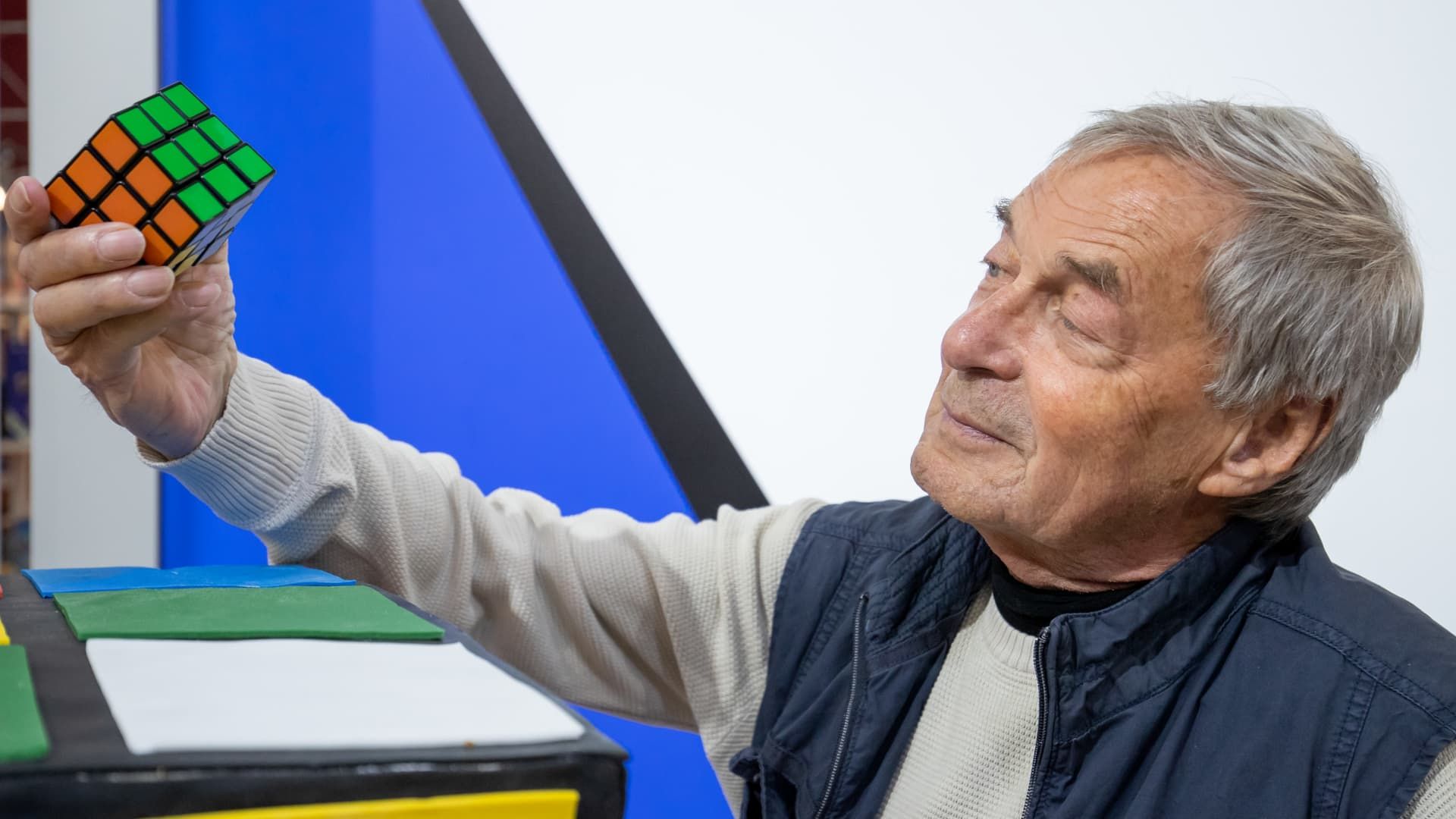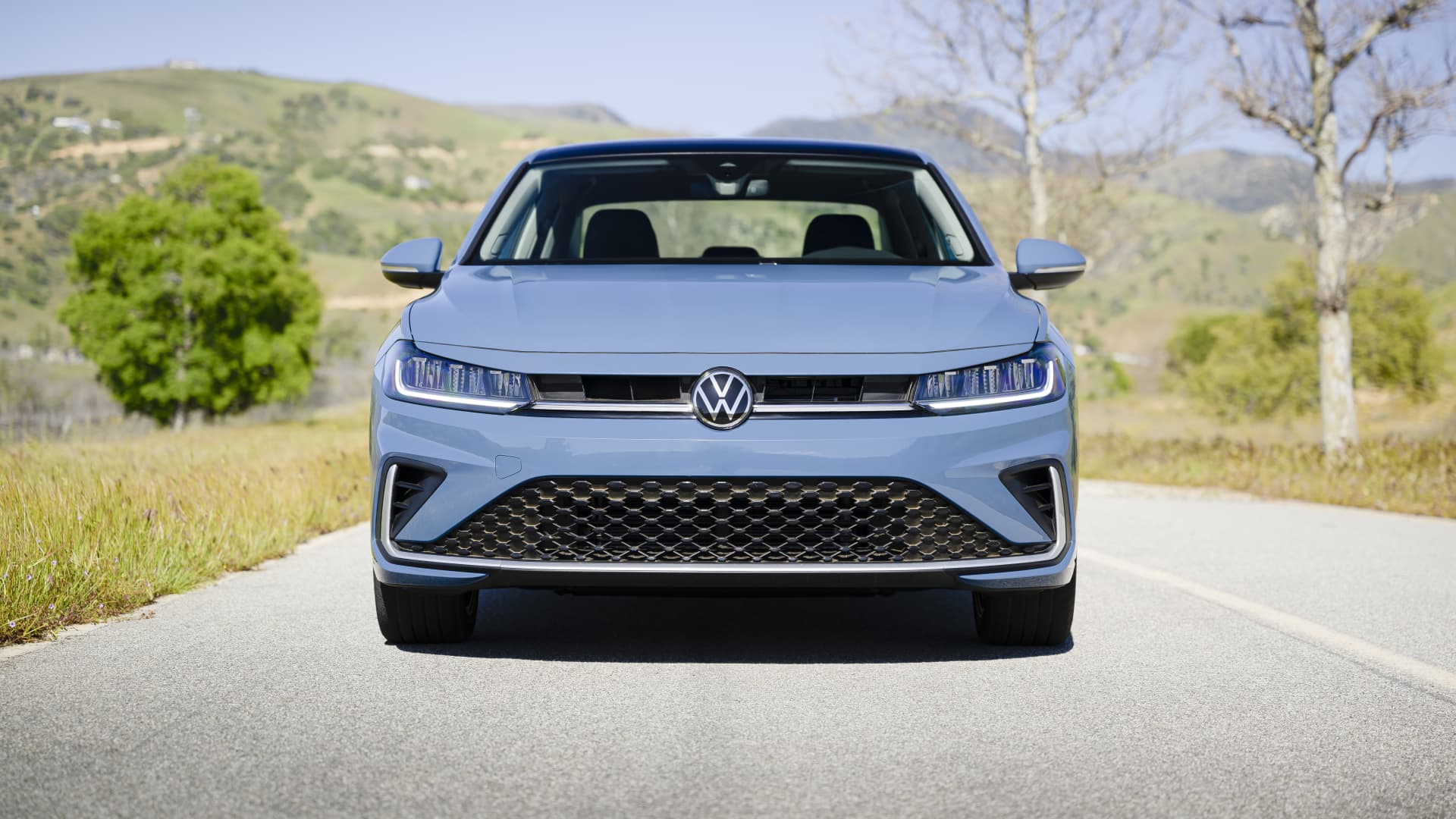Erno Rubik, inventor of the Rubik's Cube, holds one of the cubes at the International Toy Fair in Nuremberg, Germany, on January 29, 2020.
Image Alliance | fake images
It took a month of back and forth for the first person to solve a Rubik's cube. That person was Erno Rubik, now 79, the creator of the iconic puzzle.
Conceived as a mathematical tool to help its students understand three-dimensional movement, the magic cube, as it was initially called, was first constructed from cubes made of wood and paper held together with rubber bands, glue, and paper clips.
Only after the Hungarian sculptor and architecture professor scrambled his entire cube and tried to realign the colored blocks did he realize he had created a puzzle.
“I thought, if I can't do it, no one else can do it, or very few can do it,” Rubik told CNBC. “That was proof that it was possible to put it on the market, to demonstrate it to the public.”
A source of pride, envy and frustration, the Rubik's Cube turns 50 this year and, under the ownership of Spin Master, shows no signs of retirement.
“Rubik is not just a toy,” said Sam Susz, senior director of global marketing at Spin Master. “It's art. It's a sport. It's science. It's mathematics.”
Since its creation in 1974, the Rubik's Cube has spread across the pop culture landscape, appearing in movies and television shows, music videos, comics, video games, and museums. The iconic 3-by-3 grid has adorned t-shirts, been turned into keychains, inspired architecture, and sparked an entire subgenre of art.
Enthusiasts have raced to reduce the cube creator's month-long solve time, with the current world record sitting at just 3.13 seconds.
Rami Sbahi auditioned for “America's Got Talent” in 2014 by quickly solving a Rubik's cube with both his feet and hands.
NBC | Nbcuniversal | fake images
“I would put Rubik's in the category of toy and game brands that transcended and became lifestyle brands,” said James Zahn, editor in chief of “The Toy Book” and senior editor of “The Toy Insider.”
An obvious acquisition
Toronto-based Spin Master, known for brands such as Hatchimals, Tech Deck and Kinetic Sand, acquired the Rubik's Cube brand in 2021, five years after acquiring the iconic Etch-a-Sketch.
“I mean, in the toy and games industry it's not often that you come across the opportunity to acquire an iconic, permanent brand,” Susz said. “And this brand is something that has incredible staying power.”
Adding timeless, proven products to its portfolio allows Spin Master to take risks with new brands, knowing it has a set of products that will always have a space on retail store shelves.
“Rubik's is just a brand that shows no signs of ever going away,” Zahn said. “It will always be considered a classic.”
According to Susz, the cube currently has a 42% market share in the puzzle category. And sales continue to grow.
In 2022, global retail sales of the Rubik's Cube grew nearly 4% year-over-year and reached $75.3 million, the result of nearly 6 million units sold. That figure does not include tens of millions of dollars in sales of related Rubik's-inspired cubes, Susz said. As of November 2023, year-to-date sales are up 14% over 2022.
Spin Master generated just over $2 billion in revenue in 2022, making Rubik's Cube sales account for just under 4% of the company's total profits that year.
“The only important element of its longevity is the fact that every year new people discover it,” Zahn said.
Much of the Rubik's Cube's staying power is tied to its complex nature (43 quintillion combinations, Rubik says) and the human drive to solve problems.
Terence Wilson, 14, from Deepdale, near Preston, with his Rubik's cube and Rubik's snake, on 28 August 1981.
Mirror Image | fake images
Parents and educators have gravitated toward the cube as a way to keep kids out of the digital world and help them develop dexterity and critical thinking skills.
Spin Master is also in the process of starting Rubik's Academy, an educational program that provides teachers with lesson plans that integrate the puzzle toy into the classroom.
“It's absolutely fantastic for kids with learning disabilities,” said Amanda Gummer, a child development expert and founder of toy review site “The Good Play Guide.” “It helps them gain confidence and when they master it, it's kind of a cool show off on the playground.”
The next 50 years
While the traditional Rubik's Cube remains popular, Spin Master has been quick to develop new versions of the cube.
This includes Rubik's Phantom, the familiar 3-by-3 cube printed with thermochromic ink that appears completely black until the heat of your hands activates the colors, and Rubik's Impossible, a cube with iridescent tiles that change color when viewed from different angles. .
“There is probably no challenge more difficult than trying to innovate on something that has been around for 50 years and that everyone has done their best with,” Susz said.
Spin Master also wants to make cube solving more accessible. In addition to online tutorials and a Rubik's Cube mobile app, the company has developed Rubik's Cube Coach, covered in numbered stickers that correspond to each step needed to solve the cube.
The goal, after 50 years, is to maintain the momentum.
Spin Master is working closely with brands like Barbie, Hello Kitty, Levi and Mattel's Mercedes to launch new products, from toys to clothing and even a Formula 1 racing car. There's even hope the company will develop a movie about the Rubik's life, similar to movies like “Air,” “Blackberry” or “Barbie,” Susz said.
Spin Master expects sales growth to continue in 2024 as it introduces new versions of the cube.
“One of the advantages of Spin Master having full control and ownership of Rubik's globally is that we can now invest in a big way,” Susz said.









